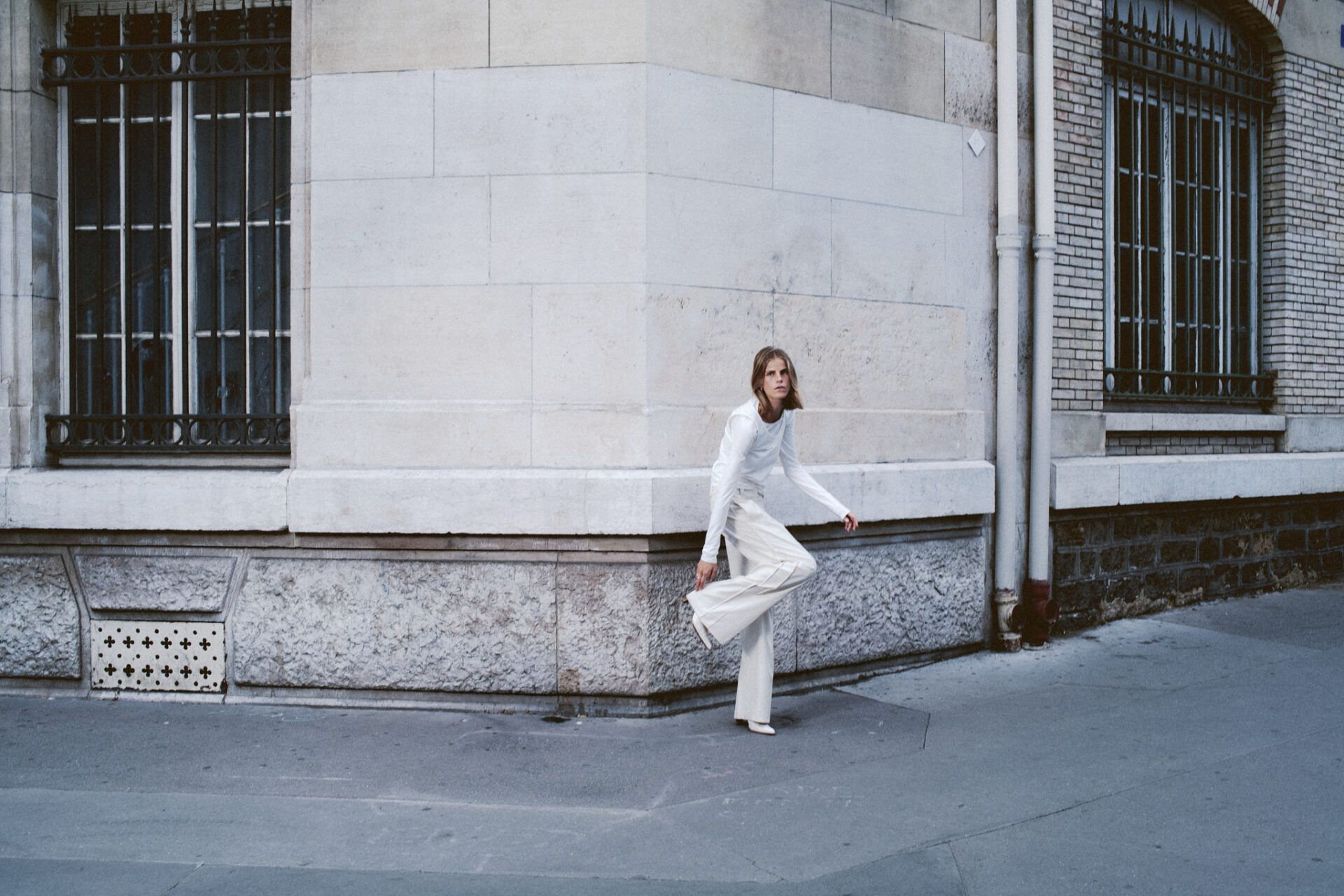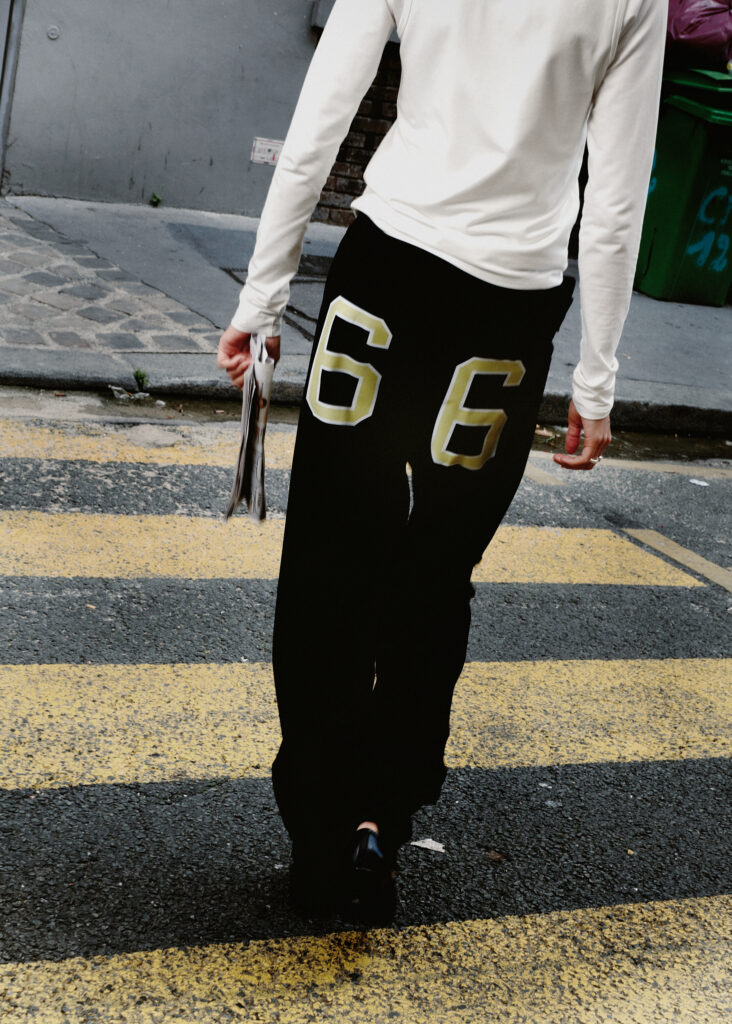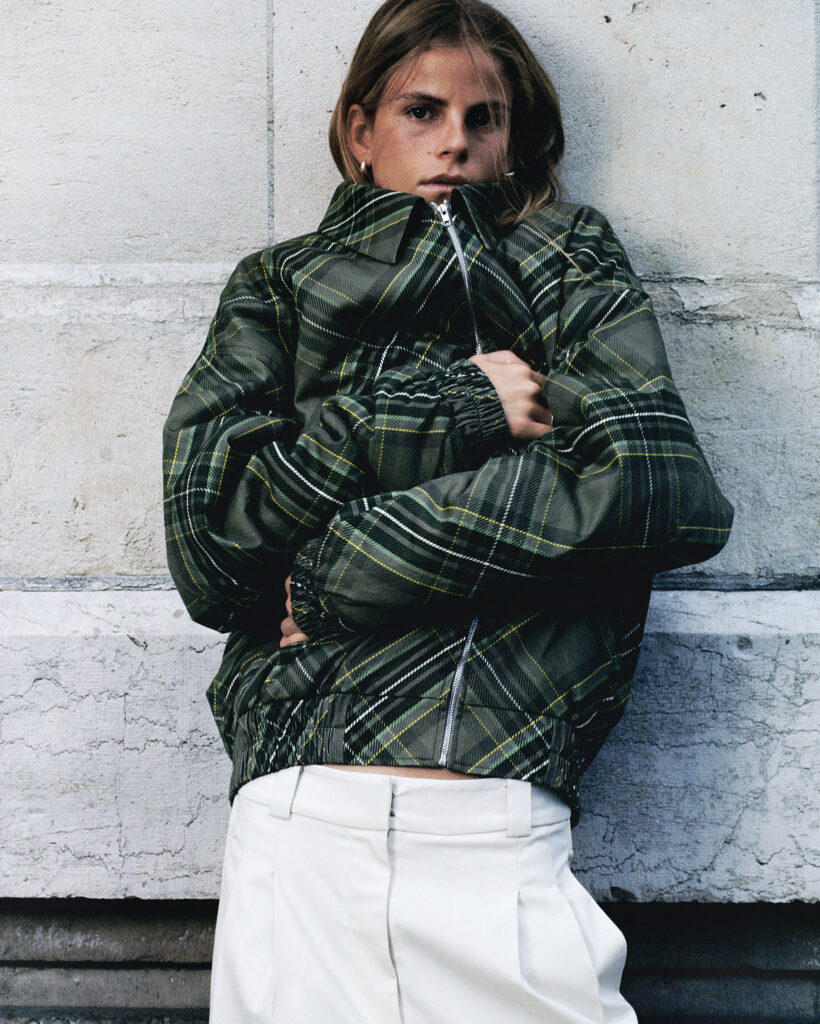Jemima Mikulic On Launching Her Brand, Lova Mohan

Jemima Mikulic embraced the challenge of creating her brand Lova Mohan with enthusiasm. After earning her degree in fashion from RMIT University and gaining experience as a styling assistant, Mikulic was eager to “take the first steps” and strike out on her own. After four months of teasing her collection, she finally released her first capsule in March this year. Consisting of three garments, the capsule included a bomber jacket and suit pants, available in two colourways each, and a two-piece cream T-shirt adorned with a large number six graphic. While the first release was modest in size, Mikulic’s approach for the future is considerate. By proceeding gradually, taking each step carefully and learning continuously, she wants to cultivate a unique voice in Australia’s fashion community.
Rachel Weinberg Jem, I think we should start with some bio. You studied fashion design at RMIT. What was that experience like?
Jemima Mikulic Yes, I studied fashion design and graduated during COVID, which made it tricky and changed my perception of university overall. Throughout my course, there was a lot of doom and gloom surrounding the fashion industry, which really tarnished my view of it. I graduated not really wanting to be a part of the industry, which felt very confusing.
RW Why not?
JM We learnt a lot about sustainability and the negative aspects of the fashion industry. I think that, paired with COVID, made me get a bit too existential about the fashion industry. It took me a while to figure out how I did want to be part of it. A mentor at the time said to me that the industry was going to exist regardless of whether or not I’m in it and I may as well give it a go and change what I can along the way. She said I should explore the avenues that I could go down and take it from there; join it, be a part of it and then decide if it’s what you want.
RW Did you know which field you were interested in joining or willing to pursue professionally?
JM I really had no idea what area I wanted to investigate, but I knew that it was going to be fashion-related. I definitely wasn’t interested in design at first. At university, I did the associates degree, which allowed me to learn a really broad range of skills, but design always seemed so complicated and confusing. The tutors really pushed this idea that we would work for a big company, and that was never attractive to me, and it didn’t seem very creative. To be fair, a lot of the fashion industry isn’t very creative; it’s very technical and skill-based.
My first step actually ended up being styling. I was at a party and I met an old high school friend who was assisting a stylist at the time. She was about to leave and told me I should take her spot and see if I liked it. I said yes and that was my first job in the industry, which was amazing.
RW When you started styling, what were your first impressions of the industry?
JM It wasn’t as creative as I imagined it to be. It was maybe 10% creative and 90% technical, running around, logistics. That was definitely reiterated when I was doing styling. That’s not to say it wasn’t still very exciting. Being exposed to the marketing and production part of fashion showed me how many creative and inspiring people were actually in Melbourne, how much work there actually was out there and how many people were willing to do those projects. It was a really great way to start. Reflecting now, it puts a very different lens on designing and starting a brand.
RW What parts of styling made you realise that you wanted something more or else?
JM I really like how styling can reinforce a story. I think you can take styling as deep as you want. There is really a psychology behind it, where we can build characters and plot lines, consider the context and ask why someone would actually wear a garment and what it means. I also love the exposure to brands and connecting with people. But, for the last few years, I felt like I had to take a risk and move away from assisting people and find my own voice. I think you don’t oftentimes get things done unless you have to so I took a step away and left full-time assisting. From that point onwards, it was, Okay, well, I’ve already taken the first step, so I need to keep going. It’s already happening.
RW When you were taking those first steps, did you feel confident and know what to do?
JM No! I knew the things that I’d learnt at university. I knew I had to have a Tech Pack and have a manufacturer. I knew in theory how it all worked, but then I had to actually figure it out. That took a long time. I spent a lot of time googling and asking ChatGPT questions. I wanted to just learn and see if I could figure it out. I wanted to experience all aspects of the fashion industry and see what worked for me and what came naturally. The technical stuff doesn't really come naturally, but I’m figuring it out.
RW Where do you go to figure it out?
JM I found an agency in Australia that acts as a point of contact. They will set you up with factories, give you Tech Packs and forms to fill out so that you don’t have to create your own, which was really nice having that base and that safety net to resort to.
RW Is that a common practice?
JM I don’t think so. I think it’s more common to either pay someone to do all your technical stuff and then take that to a manufacturer or just do it all yourself and hope that it works out. But the agency was great. They also link you up with ethically certified people, which was such a big help. The factory that I ended up working with is amazing. They're really keen to work with small businesses. We went back and forth for quite a while talking about fabrics. That was another thing that I didn't really know that much about. I would try and describe what I was looking for, and then they would send me back a swatch. It can be difficult to manufacture overseas because you have to wait a couple of weeks to get a sample of fabric and then send it back again. But the samples they sent ended up being amazing and I actually shot my campaign in Paris with my first samples. They weren’t exactly the same as what I’m selling now, but they were good enough that I could do my first shoot with them.
RW And then going back to the design part of it, where did you draw inspiration for the silhouettes and garment styles? Do you think the clothes are a representation of you and your style, or were you looking out into the world?
JM I think the brand is an extension of me and my personal style, which can make it quite hard to articulate when people ask me what clothes they are. It does feel very personal. I think my personal style is very aligned with sportswear. That is something that I’m always drawn to, as well as tailoring, sharp construction and loose silhouettes. When I was designing and figuring out what I wanted this brand to be, I discovered that a common denominator between sportswear and tailoring is the idea of the uniform, whether that’s a sports uniform, a school uniform, a work uniform, or just a personal everyday uniform. That was the theme that I went for.
The first collection is very sportswear-based. I looked through my grandpa’s photo album of his athletic races and all the trophies that he won. He was a sprinter, and so he had these hilarious mini shorts and tight tops. It’s also very vintage-inspired. I feel like there’s not a lot that hasn’t already been done. And sometimes you just have to lean into that and see where that can fall in today’s trends, body types and silhouettes.
RW What are your thoughts on innovation? Are you interested in evolving the brand so that it starts to do things that maybe fewer people have done? Or do you feel comfortable repeating and returning?
JM I think fashion is an interesting one in terms of innovation. Because there’s always going to be a top and bottom. There’s not a whole world out there to explore. But I think there's something really beautiful about accepting that things have been made and have been done before. You can still take it, tweak it and personalise it. And also, you can sell it to someone who will make it their own. Every person that touches the garment along the way is going to change its outcome. I think there’s definitely room to do things differently and also portray things differently. A jacket can be styled with a shoe or marketed in a way where it comes across differently than it would normally. But it’s always still a jacket.
RW Yes, and like you said earlier, if you want to be a part of it then you should. You can contribute your creativity, ideas and knowledge without necessarily making something ‘new’ all the time. I’m sure it can still feel overwhelming to work in an industry where there’s so much going on around you.
JM Definitely. And of course, there is an inferiority complex about it because there are so many amazing people out there who have already done it and are already doing it. But I feel like I got to a point where I had no choice but to do this and just see what happens. I was excited to build a world around a brand. Whether or not people are interested in it, or it grows into something else, I feel like that’s what I had to do, and I wanted to learn from that. But it is definitely conflicting. There are so many small brands, even in Melbourne.
RW What interest have you felt from buyers so far?
JM The support has been amazing, even just in my intimate network. And that's helped with the inferiority complex because I worked behind closed doors for ages. It’s amazing that people can see that and appreciate it. I think even working on the imagery and the campaign with Harry Burmeister has really refined who sees it and how they perceive the brand. I don’t really know anything else, but in Melbourne, I feel people are so excited to support small businesses. I've had people buy things online and follow it up with an email. People commented on the photos, attended the launch and shared images on their social media. They’re not just buying the garment; they're buying the whole idea around the brand as well.
RW And they're supporting you as an emerging designer.
JM Yeah, which is crazy to think about.
RW And you had your launch a few weeks ago and dropped the first collection online a few days later. How are you feeling now?
JM There’s been a bit of a comedown. I feel like I was riding a high for a while. I know it’s a bit silly, but I really feel like I’ve given birth to something and now I have to care for it, grow it and give it all the things that it needs to survive. I need to work on social media. I need to reply to the DMs. I need to think about the next collection, keep supporting the business and then see where it goes naturally. I'm in caretaker mode.
RW Do you feel pressure to put out another collection quickly?
JM I think the comedown helped me realise how much work goes into it. I did all the work beforehand and then I launched it, which felt like the peak. But actually, for everyone else, that’s just the starting point. I need to uphold that, which is exhausting, but it’s also okay because I really do love it.
RW I’ve never thought about it like that. You work hard, make it happen, release it and then you feel like you’re finished. But in reality, it’s the first time it exists, and you actually have to start working for it.
JM You also have to keep expressing yourself and sharing your vision. You have to be intentional, you have to be considerate, and you have to be aware.
Shop the collection at lovamohan.com
Bottega Veneta Ushers in the Lunar New Year with Digital Installations
By Anisha Khemlani
GOYA
Help Us See Fashion Today
By Billy De Luca
Valentino Fall 2022 is Pretty in Pink
By Anisha Khemlani
Comfort Calling at Jil Sander
By Carwyn Mcintyre
Noir Kei Ninomiya
By Tara Robinson
The Power of Manifestation: Introducing Raga Malak
By Annabel Blue







